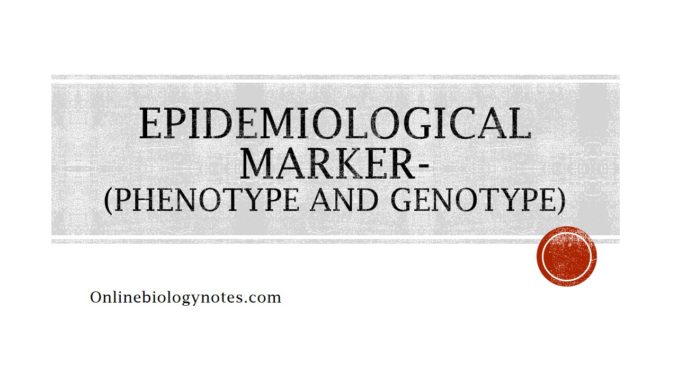
- Typing is the integral part of epidemiological investigation.
- It is the method of identification of organism upto the strain level (origin).
- Two broad categories:
- Phenotypic method (Phenotyping)
- Genotypic method (Genotyping)
Characteristics of epidemiological marker:
- Typeability
- Reproducibility
- Descriminatory power
- Ease of performance
- Ease of interpretation
Phenotypic method:
- Phenotyping method is based on the expressed characteristics.
- Characteristics of organism that is used for typing is marker.
- Organism of same source origin or source- type/strain.
- Phenotyping includes;
- Biotyping
- Serotyping
- Phage typing
- Antibiogram typing
- Bacteriocin typing
- Biotyping:
- Classified on the basis of physiological or bio-chemical tests.
- Commonly used characters are morphology, cultural characteristics, biochemical reactions (nitrate reduction test, indole test, pigment production, H2S production, carbohydrate fermentation)
- Serotyping:
- Typing method done by the use of hyper-immune anti-sera or purified immunoglobulin to detect specific antigen.
- Serotyping is generally done for Salmonella, Klebsiella, etc. for detection of O-antigen, H-antigen, R-antigen, K-antigen, etc.
- Phage typing:
- Bacteriophage typing identify strains by the pattern of specific set of phages.
- Generally used for Staphylococcus aureus and for Salmonella Typhi.
- Antibiogram typing:
- Typing method on the basis of antibiotic susceptibility or resistance pattern.
- Bacteriocin typing:
- On the basis of bacteriocin production.
Genotyping method:
- Genotyping includes;
- Plasmid profiling
- G+C ratio
- Ribotyping
- Restriction endonuclease
- RPLP
- PFGE
- PCR amplification
- Plasmid profiling:
- On the basis of no. of plasmid, size of plasmid in the organism.
- G+C ratio:
- Same strains have similar G+C ratio.
- Ribotyping:
- 16sRNA is highly specific for organism.
- Restriction endonuclease enzyme:
- Whole genome is fragmented using same set of restriction endonuclease enzyme and analyzed.
- RFLP (Restriction fragment length polymorphism):
- Particular enzyme is used to fragment whole genome.
- PFGE (Pulse field gel electrophoresis):
- Electric field is applied diagonally in two field.
- The electric field is applied and then pulsed and re-applied perpendicularly.
